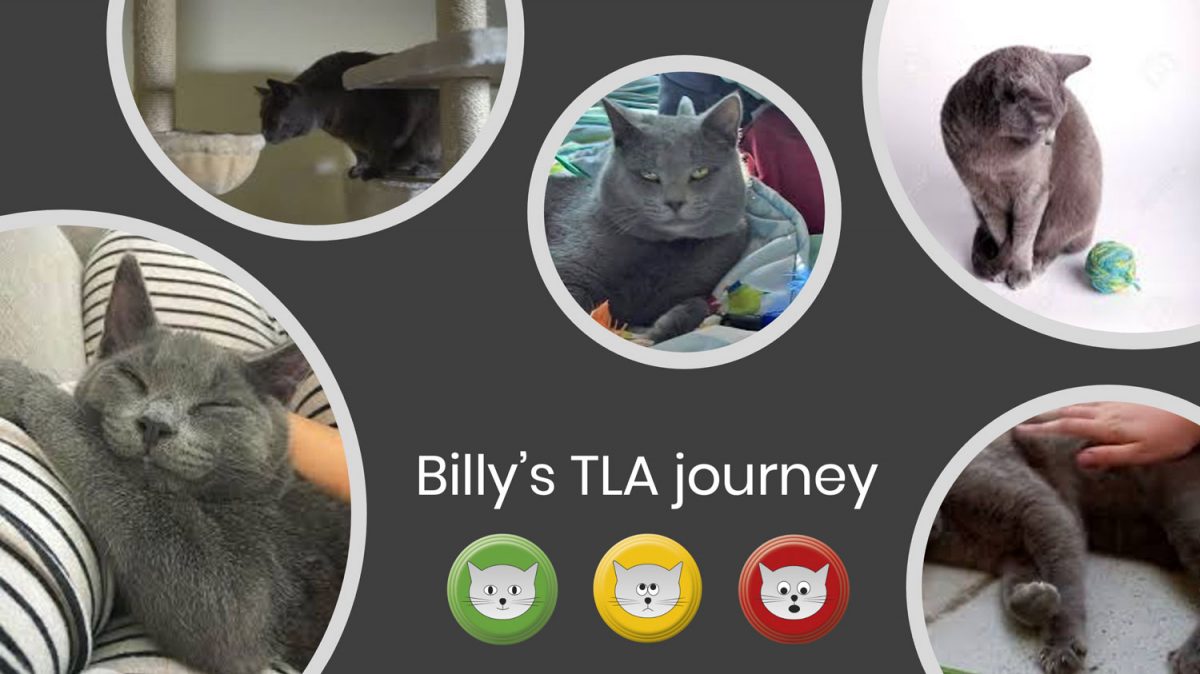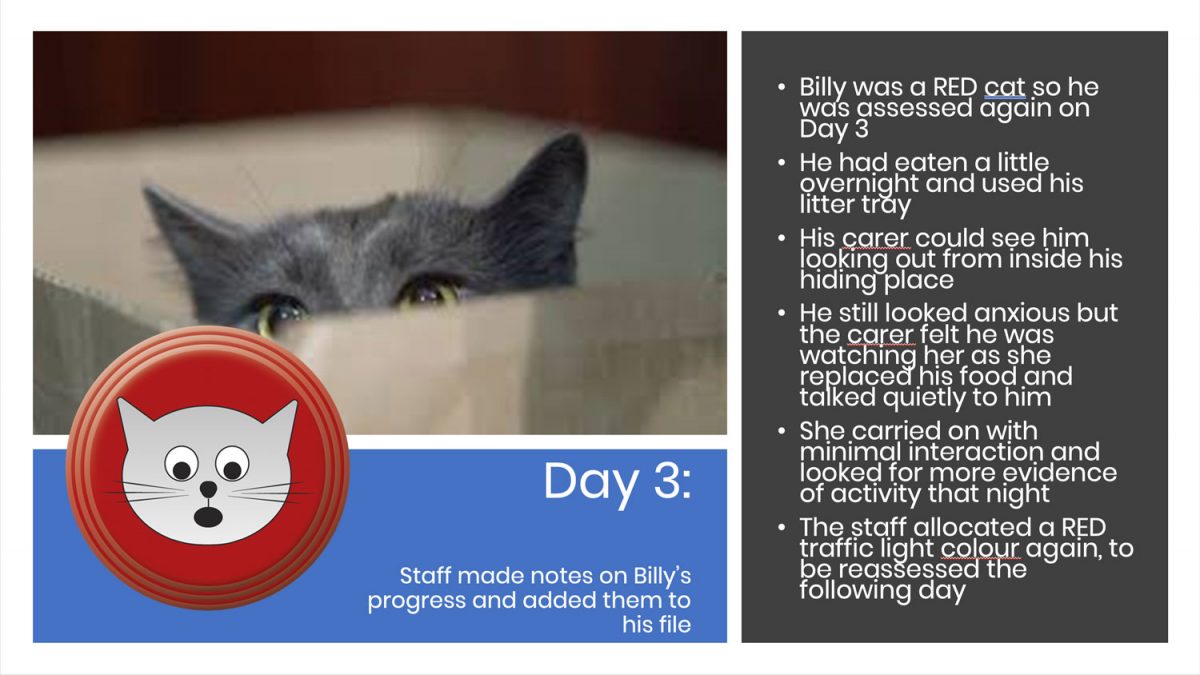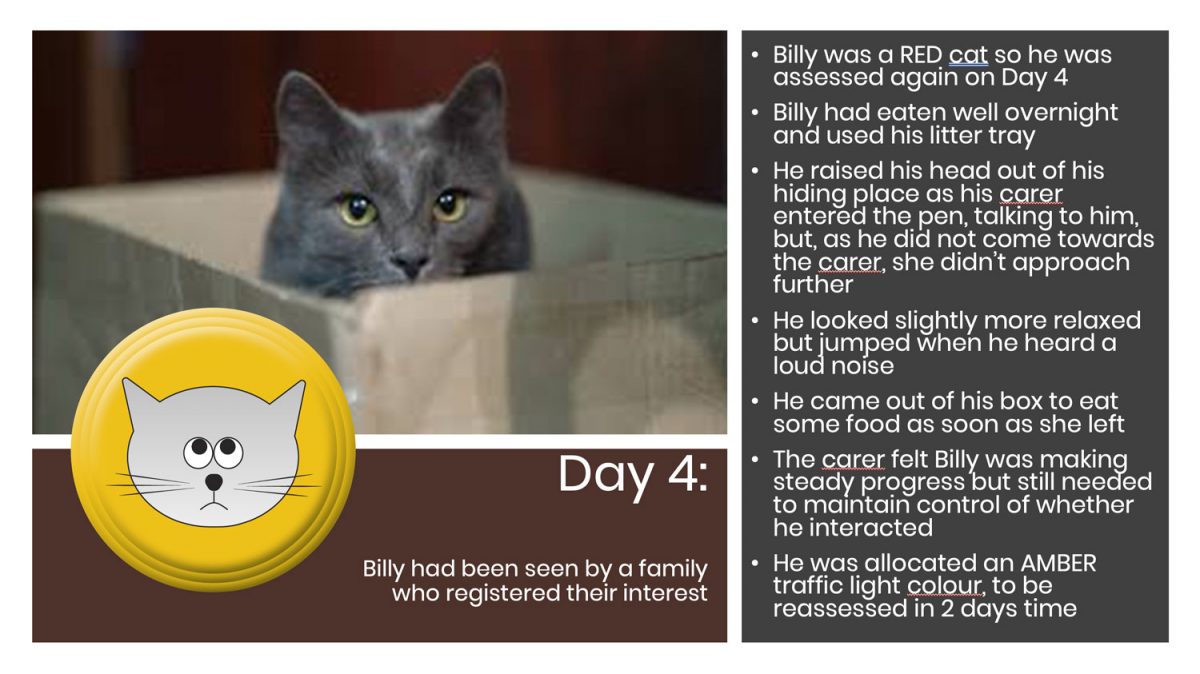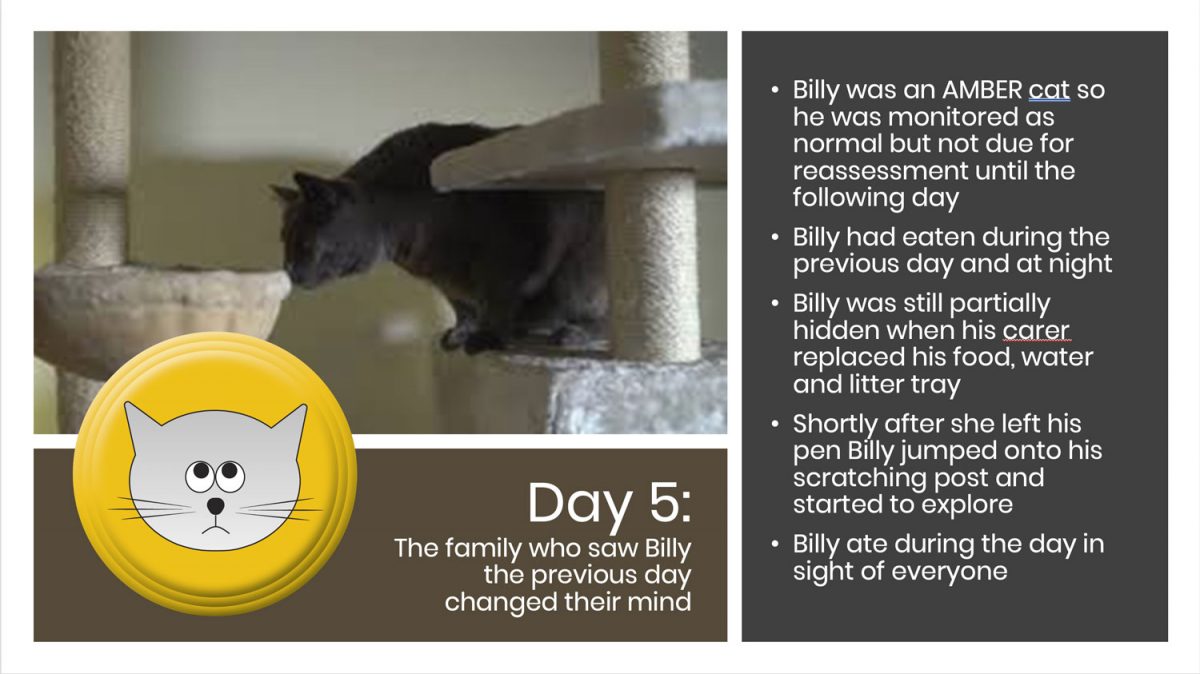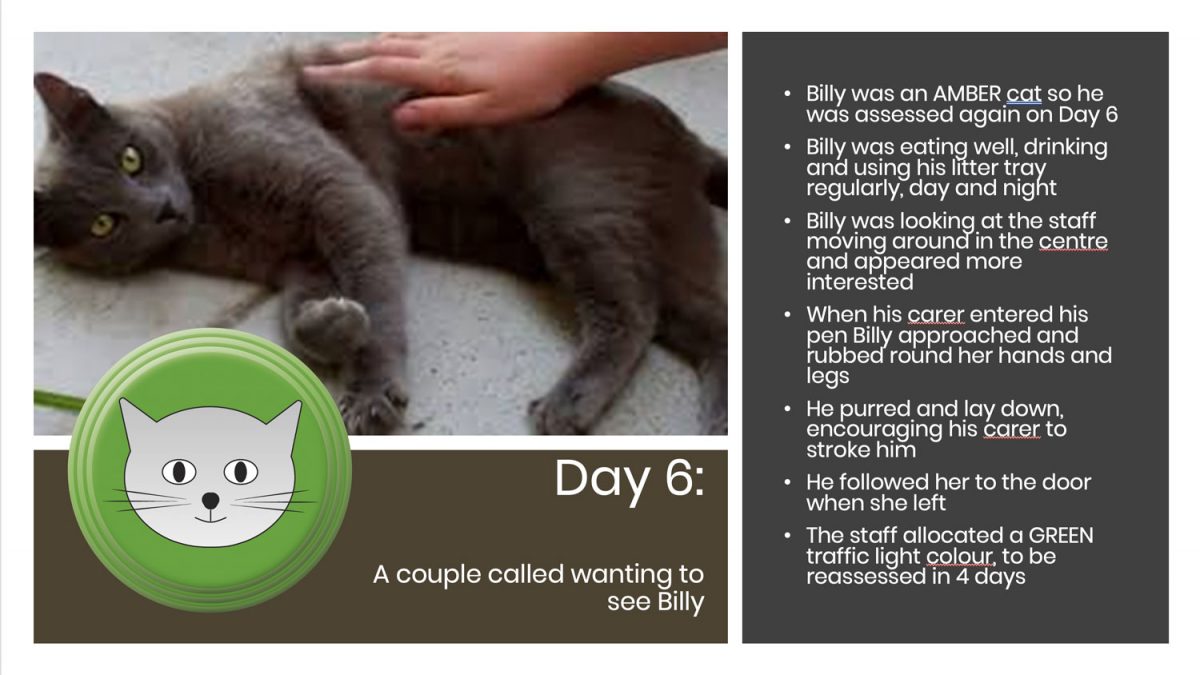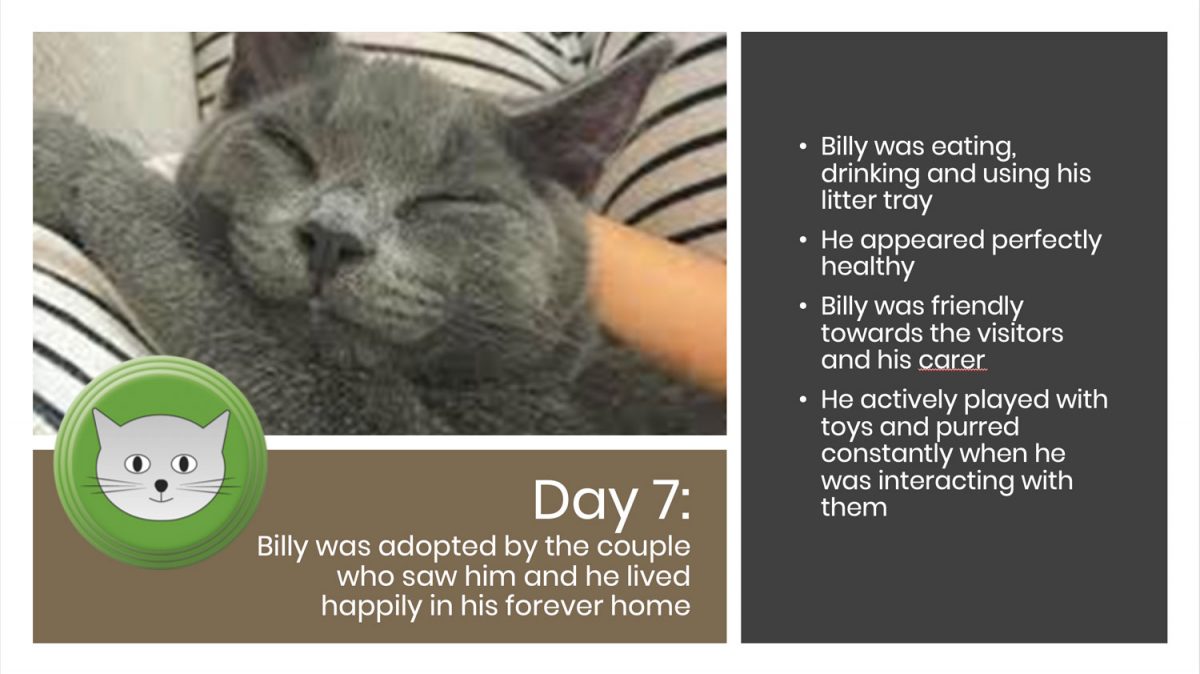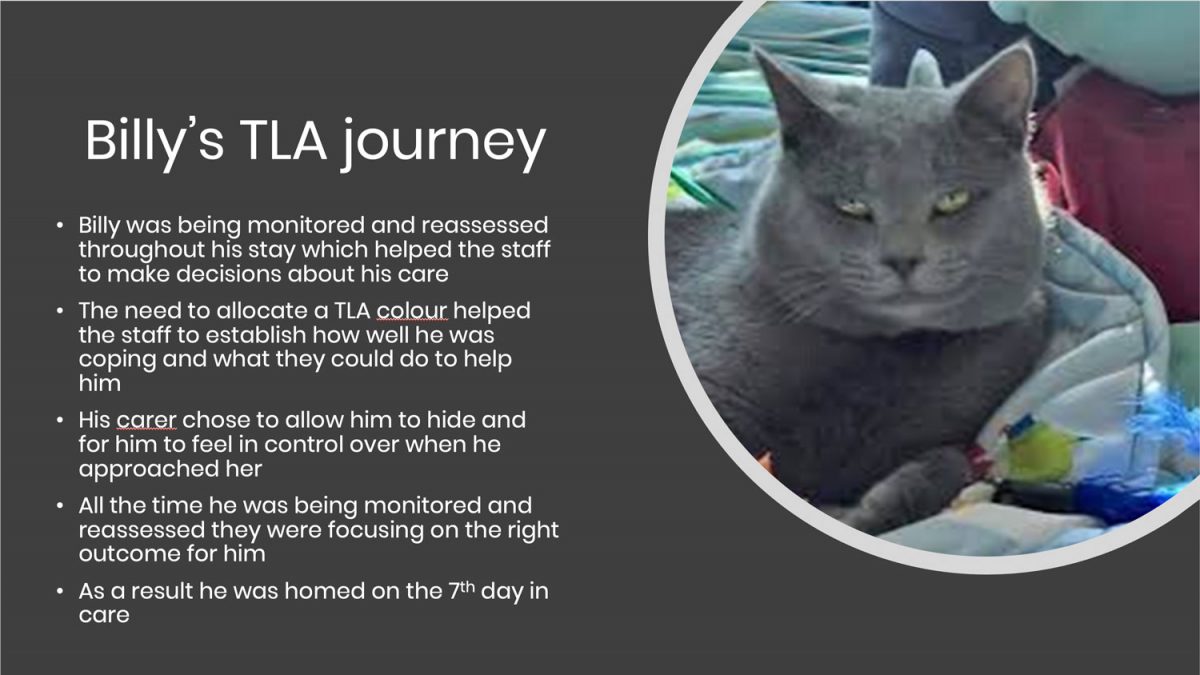 Care: Traffic Light Assessment
Care: Traffic Light Assessment
Using the Traffic Light Assessment (TLA) tool to assess whether cats are coping
Cat Friendly Homing (CFH) promotes the constant monitoring of cats in care to ensure they remain as well as possible, physically and mentally, awaiting the move to their future homes. Cats can either settle in homing centres and cope, ie, deal effectively with the difficult situation and their stress levels then reduce, or remain stressed and fail to cope during their stay (CFH refers to such cats as ‘not coping’). One of the tools you can use to help you monitor cats is called the Traffic Light Assessment (TLA).
Lights or signals, using a universal colour code of red, amber (yellow) and green are found throughout the world to control traffic. The TLA tool uses red, amber and green to indicate how well an individual cat is coping with confinement in a homing centre ie, how distressing it is finding the experience. A cat’s TLA colour will influence what you do and when, meaning that you give priority to the cats needing your help the most. CFH uses this system of colour coding as a ‘call to action’ to ensure each cat is given the best possible care and no cat is ever overlooked.
IMPORTANT: A cat’s physical health must be taken into account as this will impact on its ability to cope in a challenging environment such as a homing centre, so any improvement in physical health may enable a cat to cope better.

The Traffic Light Assessment colours
How do you assess whether a cat is red, amber or green?
Making a decision about whether a cat is red, amber or green is a team effort. It involves:
- Observation of:
- The cat’s behaviour and body language displayed within its pen/cage
- The cat’s response to its carer’s presence
- The cat’s physical health
- Consideration of any relevant information you may have about the cat’s background (eg, a cat with a history of living indoors in one property all its life may struggle with such a dramatic and unprecedented change of circumstances when it comes into a homing centre)
All red cats will not behave in the same way, neither will all amber or all green. How each cat shows whether it is coping or not can vary from very active behaviour, eg scratching at the door and miaowing loudly, to something much more passive, eg excessive sleep, drowsy appearance or inactivity. It takes practise to identify a cat’s TLA colour. Here are some basic guidelines to help you.
No 1
Always allocate the colour that would represent the worst-case scenario – ie if the cat could be amber or red, choose red. If green or amber – choose amber.
No 2
Choose amber when you are confident a cat is not red or green (red or green cats are often easier to recognise).
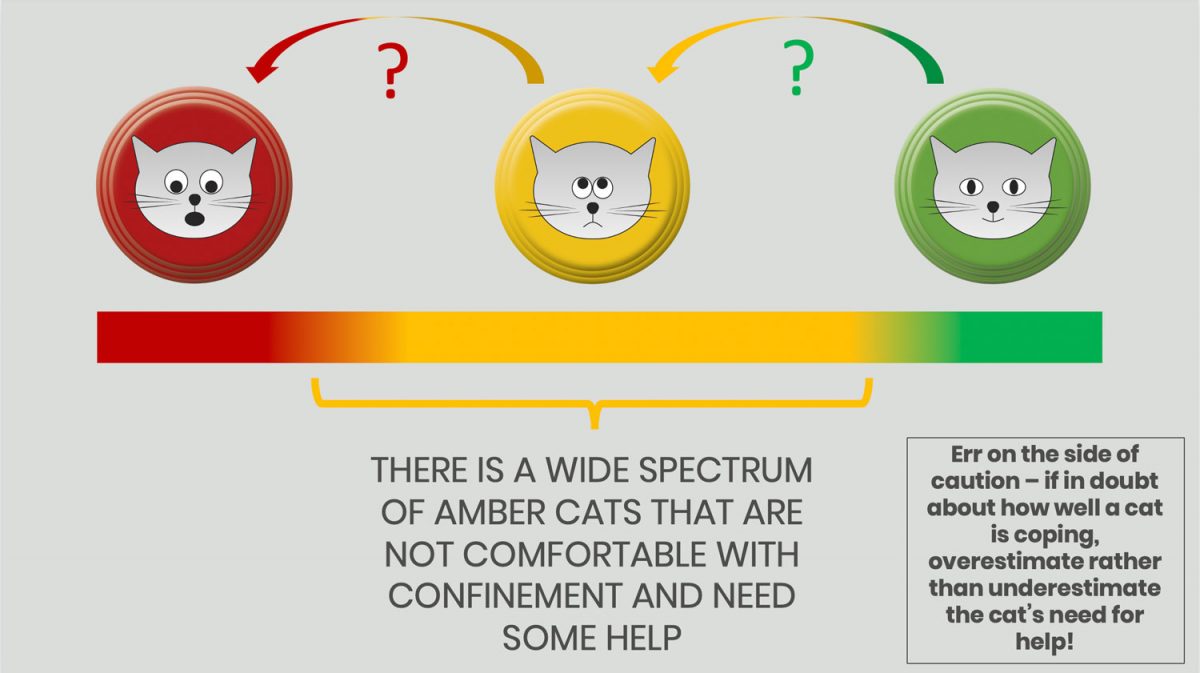
There is a wide spectrum of Amber cats
No 3
A cat’s TLA colour is not fixed and may change over time, representing either an improvement or a decline in how it is coping.
No 4
Most friendly cats with positive experience of people at a young age will be red when they first arrive and then gradually become accustomed to their new surroundings. Friendly cats will be more likely to end up as amber or green as they will tend to be comfortable around people
No 5
Unfriendly cats will be red when they first arrive and tend to remain so. Unfriendly cats will be more likely to end up as amber or red as they will tend to be uncomfortable around people
No 6
The TLA is not suitable for assessing kittens up to the age of 8 weeks (they should be undergoing a socialisation programme to ensure they gain positive experience with a variety of people and get used to different environmental sights, sounds and smells)’
Assessing body posture and behaviour to decide whether a cat is red, amber or green
Here are some ideas about body posture and behaviour you may see that is associated with each TLA colour. These videos show mainly red and amber cats that are uncomfortable because they are anxious or fearful, don’t forget that frustrated cats find it hard to cope with confinement too (look out for pacing, excessive vocalisation, disrupted pens, etc).
See this video on how do you assess whether a cat is red, amber or green:
Here are some examples of cats and their TLA colours
Video 1: This cat was hiding when the carer entered the pen and hisses in response to the carer’s hand. Look at its frozen and tense body posture, dilated pupils and flattened ears. This cat is red because it is very scared.
Video 2: This cat’s cage door has been covered to make it feel more secure. See its frozen body posture and how it turns away when the carer reaches her hand out. Watch the nose lick, blink and swallow at the end which is a sign that the cat is uncomfortable and often associated with amber cats. This cat however, in addition, is very inactive and doesn’t respond to its carer or its environment. This cat is red because its posture and inhibited behaviour suggest it is distressed.
Video 3: Although this cat chose to be in a hidden area, it was looking out of the window. When the carer arrived and pulled back the curtain the cat miaowed but made no attempt to approach her. The cat’s body language is fairly relaxed but as the carer reaches her hand out the cat looks down and licks its nose, but then appears slightly distracted by a bird outside. This cat is amber because its behaviour suggests that it may not be comfortable around people. It is not green (comfortable) and not red (failing to cope).
Video 4: This cat has its tail up and is pawing gently at the door in response to the carer. It stays with the carer while it is being stroked and seems interested in its surroundings. It looks towards the carer, its ears are upright and forward facing and its eyes are relaxed and almond shaped. This cat is green because it is comfortable around its carer and interested in its surroundings.
An illustration of how the TLA colour changes with time
Video 5: This cat has just arrived at the homing centre and is very wary. It is assessed as red because it is hiding and not interacting with the carer. Note, however, that the cat does stretch forward to investigate the carer’s hand but withdraws again to the safety of the hiding place.
Video 6: One week later the same cat is coping much better and has become green because it approaches its carer in a relaxed manner and appears generally comfortable. (Note that this cat did arrive with very sparse fur and was diagnosed with a flea allergy which was treated immediately to relieve its discomfort).
What do you do once you have assessed the cat’s traffic light colour?
The TLA helps you to recognise how comfortable, or otherwise, the cat is feeling. Once the cat’s colour has been assessed it is given an action plan, which may include:
- Discussing the individual cat with your colleagues
- Completing a quality of life assessment (QoL assessment)
- Changing the physical environment, eg altering the layout of the pen/cage, or adding extra resources
- Changing the social environment, eg altering the level of interaction with the cat according to its needs
- Developing a treatment protocol for any health issues
- Considering foster care
- Finding the right outcome for the cat as a matter of urgency (this would include those non-pet cats that have, despite intake protocols, entered the homing centre and require neutering, ear-tipping and return to where they came from – What about the feral and street cats that slip through the net and end up in the homing centre?
For example, you may create an action plan for a red cat that provides more hiding places in its pen/cage and reduces social interaction with people to a minimum, as you recognise from the TLA the cat is anxious. For another red cat, you may recognise it needs to be prioritised for a foster home as it is finding the close physical confinement of a pen too frustrating. Some red and amber cats are not coping because they are frustrated by another cat close by, so moving it to a quieter part of the centre may be helpful. For a green cat, you might introduce some more exciting feeding games or ask a volunteer to play with it twice a day to keep it stimulated and prevent it from becoming frustrated.
| Work as a team, discuss each cat and put forward your observations and your suggestions about what you might do to help it feel better. |
Continue to monitor each cat daily and make care notes as normal (observations regarding health, bodily functions, behaviour and posture), see the CARE section on physical health. You will need to reassess the cat’s TLA colour as follows:
- Red cats – every day
- Amber cats – every 2-3 days (or more frequently if you have the resources)
- Green cats – every 4-5 days (or more frequently if you have the resources)
What do I do if cats are red to start with?
When you assess a cat as red in the first few days it is tempting to take steps straight away to resolve its distress, but every cat needs time to adjust to this new and challenging circumstance.
Research shows that providing the cat is kept in as stress-free an environment as possible (following the recommendations for pen/cage set up and cat friendly interaction) the greatest reduction in stress levels should be seen in cats within the first 1-4 days. A further reduction in stress levels should be seen within a two-week period – this is called ‘habituation’ (which simply means getting used to the environment).
In the spirit of cat friendly and respectful care, it is usually best to do as little as possible during the first couple of days:
- Keep all routines predictable
- Keep interactions to an absolute minimum
- Bear in mind that a cat’s failure to cope may be associated with physical illness, so ensure a veterinarian is informed if you have any concerns
If the cat is physically healthy, you should notice a change in behaviour within those first few days as it adapts to its environment (if it can). You can then provide the cat with what it needs based on your observations and subsequent TLA colour.
What do I do if a cat remains persistently red?
If you are caring for a cat that seems to be failing to settle within those first few days, despite doing the basics to make it feel comfortable, then you need to follow an action plan (outlined in the next section) so that every step can be taken to help the cat.
Here is an example of the TLA in action – Billy’s TLA Journey
The action plan
Any action plan should consider what would help the individual cat based on the cat’s response to its surroundings and the people in it. There are options to:
- Discuss the individual cat with your colleagues
- Complete a quality of life assessment (QoL assessment)
- Change the physical environment (eg alter the layout of the pen/cage, or add extra resources)
- Change the social environment (eg alter the level of interaction with the cat according to its needs)
- Develop a treatment protocol for any health issues
- Consider foster care
- Find the right outcome for the cat as a matter of urgency
Discuss the individual cat with your colleagues
The following series of questions can form the basis of your discussion about each individual cat when you are deciding what action plan to put in place. They will help you to re-evaluate the cat’s situation at regular intervals. The emphasis is always on doing the very best for the cat. What can we do to better meet the needs of this cat to improve its current and future welfare?
You will find that not all the questions listed below are relevant to every cat in your care. You may prefer to adapt this list – add some more questions that you feel are more meaningful to your situation or leave out some that you don’t find useful or don’t reflect the kind of situation you encounter. The important thing is to talk with your colleagues, discuss every cat and don’t be afraid to ask questions that might be difficult to answer.
These questions work well if they are answered honestly and reasons are given for objections raised to any decisions that may be made based on those answers. This can be a very positive process as it enables all members of the team to have input and it may result in innovative ideas being employed for individuals with very specific needs.
Each cat should be discussed, using documented records for the individual. The emphasis should always be to improve the situation for each cat, for example, how can we enable this red cat to move to amber?
Everything that is discussed has to be balanced with realism regarding what types of homes are likely to be found. The perfect prospective owner may walk through the door at any time or you may find the ideal alternative lifestyle but, unfortunately, this may not happen, so educated decisions (ie likelihood versus probability) need to be made.
The action required will probably be apparent, based on the answers to the questions below. It should be made clear which individual or team is responsible for making any necessary changes or carrying out any decisions.
TLA – suggested questions
| QUESTION | ACTION | RELEVANT TO RED, AMBER OR GREEN? |
| PHYSICAL HEALTH | ||
| Always ask the following questions on a daily basis: | ||
| Is the cat eating, drinking, grooming, urinating and defecating? If there are any concerns regarding these basic functions, what steps are being taken to address this? | Refer to veterinarian | √ √ √ |
| Are there any other health concerns? | Refer to veterinarian | √ √ √ |
| The following questions may apply if there is an ongoing health issue: | ||
| Has this cat’s health improved or deteriorated since it arrived? Is the cat’s condition progressing as expected? If not, what is the reason for the slow progress? | Refer to veterinarian. Any deterioration should be discussed urgently. | √ √ √ |
| How easy is it to provide the cat with essential medication? Is the cat coping with treatment: is it amenable? Distressed? Is there another way to administer the drug that may be more acceptable to the cat, eg injection rather than a tablet? If the cat is distressed by any interventions, is the cat’s quality of life (QoL) being compromised? | Refer to veterinarian regarding treatment options. Do a QoL assessment, discuss with your veterinarian. | √ √ √ |
| Is the cat eating enough for its condition to improve? Is pain preventing it from eating? Is the right food being given? | Refer to veterinarian | √ √ √ |
| What do you consider the cat’s quality of life to be at this moment? Potentially in the future? | Do a QoL assessment, discuss with your veterinarian | √ √ √ |
| How can this cat’s quality of life be improved now? | Do a QoL assessment, discuss with your veterinarian | √ √ √ |
| Should the cat’s TLA colour be changed based on the above? | Change the colour and reassess accordingly, ie red: daily, amber: 2-3 days, green: 4-5 days | √ √ √ |
| You can add any other questions you may wish to ask here | ||
| MENTAL WELLBEING | ||
| Monitor daily but ask these questions every time you reassess cats: | ||
| Does the cat’s environment offer the opportunity for it to express natural behaviour*? What natural behaviour* has been observed? | Alter the cat’s physical environment in the pen/cage if the cat does not have the room or facilities to behave naturally | √ √ √ |
| Are there routines in place to create a sense of security and predictability for this cat? | Ensure all activity in and around the pen/cage occurs at a routine time and in a similar way so that the cat can predict what might happen. Ensure the cat has plenty of opportunities to hide | √ √ √ |
| Has there been any deterioration in this cat’s behaviour since its arrival suggesting it is not coping any more (this could be demonstrated by changes in type and level of activity, eg sleeping excessively)? If so, is there anything that could be done to improve the cat’s mental wellbeing or prevent further deterioration? | Refer to veterinarian as changes may reflect a deterioration in the cat’s physical health. Consider possible changes to the social and physical environment, eg less or more interaction with people, play sessions, review of cleaning protocols to minimise disruption | √ √ √ |
| Have you observed any changes in this cat’s behaviour that suggests it is becoming more comfortable? | Take action to ensure this improvement continues; did it coincide with certain changes being made in a previous action plan? Ensure these are maintained. | √ √ √ |
| Should the cat’s TLA colour be changed based on the above? | Change the colour and reassess accordingly, ie red: daily, amber: 2-3 days, green: 4-5 days | √ √ √ |
| Can this cat reasonably be expected to change to amber during its stay?
What steps, if any, can be taken to change this cat’s colour from red to amber? |
Consider this cat’s outcome as a matter of urgency. Do a QoL assessment, discuss with your veterinarian | √ |
| You can add any other questions you may wish to ask here |
| *Natural behaviour
Natural behaviour refers to those things that a cat does every day that are normal for the species. These include climbing, scratching, hiding, playing, hunting, grooming, exploring, jumping, walking, running, sleeping, eating, toileting etc. Cats can get distressed when they have no opportunities to do these things in a comfortable and safe way. Such distress can display itself as frustration when the cat is prevented from doing something it is motivated to do and as fear or anxiety when it does not feel safe. Every cat may spend a different amount of time doing some, or all of, these things in a typical day. When cats are distressed or unwell their normal routines, including the amount of time they spend climbing, scratching, hiding etc, can change and this may be the only clue you have to alert you to the fact that something is wrong. They tend to not do something at all or do it to excess. For example, the following may be cause for concern:
|



